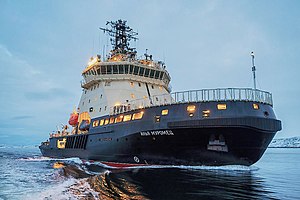 Ilya Muromets deployed with the Northern Fleet. Ilya Muromets deployed with the Northern Fleet.
| |
| History | |
|---|---|
| Name | Ilya Muromets (Илья Муромец) |
| Namesake | Ilya Muromets |
| Owner | Russian Navy |
| Port of registry | Murmansk |
| Builder | Admiralty Shipyard, Saint Petersburg, Russia |
| Yard number | 02470 |
| Laid down | 23 April 2015 |
| Launched | 10 June 2016 |
| Commissioned | 30 November 2017 |
| Identification |
|
| Status | In service |
| General characteristics | |
| Type | Icebreaker |
| Tonnage | |
| Displacement | 6,000 tons |
| Length | 85 m (279 ft) |
| Beam | 20 m (66 ft) |
| Draft | 7 m (23 ft) |
| Depth | 9.2 m (30 ft) |
| Ice class | RMRS Icebreaker6 |
| Installed power | 4 × Wärtsilä 6L32 (4 × 3,000 kW) |
| Propulsion | Diesel-electric; two Steerprop SP120CRP ECO propulsion units (2 × 3,500 kW) |
| Speed | 15 knots (28 km/h; 17 mph) |
| Range | 12,000 nautical miles (22,000 km; 14,000 mi) |
| Endurance | 60 days |
| Capacity | 500 tons of cargo in containers |
| Crew | 32 |
| Aviation facilities | Helideck |
Ilya Muromets (Russian: Илья Муромец), Russian designation Project 21180, is a Russian icebreaker built by Admiralty Shipyard in Saint Petersburg and commissioned on 30 November 2017. She is the first icebreaker built for the Russian Navy in almost 40 years.
Development and construction
In March 2014, the Ministry of Defence of the Russian Federation announced that the Russian Navy would receive a new auxiliary icebreaker as part of the ongoing fleet renewal program. The vessel, designed by the Russian Vympel Design Bureau as Project 21180, would be the first new military icebreaker built in Russia since the Soviet era.
The construction of the new auxiliary icebreaker was awarded to Saint Petersburg-based Admiralty Shipyard. The keel of the vessel was laid on 23 April 2015 and she was launched as Ilya Muromets on 10 June 2016. After completing sea trials, the vessel was officially delivered to the Russian Navy in a flag-raising ceremony on 30 November 2017.
Ilya Muromets is the fourth icebreaker named after the Russian folk hero: the first was a 1915-built steam-powered icebreaker later captured by the French; the second a 1941-built steam-powered icebreaker acquired from Germany as war reparations; the third a 1965-built diesel-electric Dobrynya Nikitich-class icebreaker.
While initially the 6,000-ton Ilya Muromets was intended to be the lead ship of a series of four icebreakers, the Ministry of Defence decided not to begin the serial production of the Project 21180 due to high cost of the vessels. Instead, it will focus on building smaller Project 21180M icebreakers with about two thirds of the displacement and more limited functionality compared to the bigger vessel.
Design
Although the 6,000-ton Ilya Muromets is the largest icebreaker ever built for the Russian Navy, she is somewhat smaller than the civilian icebreakers operated by Atomflot, Rosmorport and Sovcomflot. In terms of size and general layout, the 85-metre (279 ft) vessel is comparable to the civilian Project MPSV06 multi-purpose salvage vessels with a working deck aft, deckhouse amidships and a helideck rated for Kamov Ka-27 helicopter. Like her civilian counterparts, Ilya Muromets is also equipped with a towing winch and stern notch for escorting other ships in ice conditions.
Like most icebreakers today, Ilya Muromets has an integrated diesel-electric propulsion system where the main generators provide electricity for both propulsion and auxiliary systems. The vessel's power plant consists of four 3,000-kilowatt (4,000 hp) 6-cylinder Wärtsilä 6L32 medium-speed diesel generating sets. Ilya Muromets is one of the few ice-going vessels propelled by contra-rotating propellers: the vessel has two electrically-driven 3,500-kilowatt (4,700 hp) Steerprop SP120CRP ECO azimuthing Z-drive propulsion units with five blades on the pulling and four blades on the pushing propeller. This configuration provides higher propulsion efficiency at a cost of added mechanical complexity. In addition, the vessel has a bow thruster for maneuvering.
Ilya Muromets is classified by the Russian Maritime Register of Shipping. Her ice class, Icebreaker6, requires the vessel to be capable of operating in level ice with a thickness of 1 metre (3.3 ft) in a continuous motion and her hull strengthened for navigation in non-Arctic waters where ice can be up to 1.5 metres (5 ft) thick.
References
- ^ "Ilya Muromets (9820233)". Sea-web. S&P Global. Retrieved 2018-01-02.
- ^ Keel-laying of 21180 icebreaker ILYA MUROMETS at Admiralty Shipyards. PortNews, 23 April 2015. Retrieved 2017-09-06.
- ^ Admiralteiskie Verfi launched the icebreaker ILYA MUROMETS. PortNews, 10 June 2016. Retrieved 2017-09-06.
- ^ Admiralteiskie Verfi shipyard delivers icebreaker Ilya Muromets, Project 21180, to RF Navy (photo). PortNews, 30 November 2017. Retrieved 2017-12-01.
- ^ "Ilya Muromets (9820233)". Equasis. Ministry of Ecology, Sustainable Development and Energy. Retrieved 2017-09-06.
- Минобороны России закупит перспективные корабли и подводные лодки для Военно-Морского Флота. Ministry of Defence of the Russian Federation, 25 March 2014. Retrieved 2017-10-11.
- Дизель электрический ледокол мощностью 7 МВт (проект 21180) Archived 2017-10-11 at the Wayback Machine. Конструкторское бюро по проектированию судов «Вымпел». Retrieved 2017-10-11.
- ^ Project 97 icebreakers. RussianShips.info. Retrieved 2017-10-11.
- Американский вариант ледокола с носовым винтом. Retrieved 2018-12-25.
- Илья Муромец (Eisbar). FESCO. Retrieved 2018-12-24.
- 12 тысяч миль льда за 60 суток. Военные ледоколы 5-го поколения будут патрулировать Арктику. ТРК Звезда, 4 April 2015. Retrieved 2017-10-10.
- Ледоколы дошли до "Алмаза". Kommersant, 13 April 2017. Retrieved 2017-10-10.
- ^ Profile view of the vessel. Retrieved 2017-10-10.
- О нас. ООО «Морские Пропульсивные Системы». Retrieved 2017-09-06.
- Photograph of the propulsion unit. Retrieved 2017-10-10.
- Nord-West Sea Business № 2 (39) For Russian Navy. June 2015. Retrieved 2017-10-10.
- Rules for the Construction and Classification of Sea-Going Ships Vol 1, 2017 Archived 2017-10-12 at the Wayback Machine. Russian Maritime Register of Shipping. Retrieved 2016-07-21.